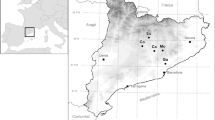Abstract
The common ragweed, Ambrosia artemisiifolia is a widespread invasive weed species in Europe. In order to estimate the deteriorative effect of native arthropods on the invasive ragweed the effect of three indigenous aphid species on plant development and pollen production was studied. Common ragweed plants grown in a greenhouse were artificially infested with five apterous individuals of either Aphis fabae, Brachycaudus helichrysi or Myzus persicae at the 4-leaf stage. Feeding by all three aphid species over a 5-week period significantly reduced plant height, the number of male inflorescences, the length of racemes, pollen emission and plant dry mass. Brachycaudus helichrysi produced the largest colonies, followed by A. fabae and M. persicae. In a host plant choice test, B. helichrysi showed significant preference for ragweed over sunflower, whereas A. fabae preferred sunflower and M. persicae did not show any preference. In a field experiment, the growth rate of A. fabae on caged ragweed plants was similar to that in the greenhouse, but the final numbers of B. helichrysi and M. persicae after 30 days was ten and seven times lower than under greenhouse conditions, respectively. On exposed field plants, B. helichrysi was more abundant than other species. However, no aphid species affected the height or dry mass of either caged or exposed plants during a 30-day period. Under controlled conditions aphids effectively hampered development and pollen production of ragweed, however, under Hungarian field conditions the development of ragweed was much more dynamic, therefore no deleterious effect of aphid feeding occurred.




Similar content being viewed by others
References
Baskin JM, Baskin CC (1980) Ecophysiology of secondary dormancy in seeds of Ambrosia artemisiifolia. Ecology 61:475–480
Basky Z (2007) The effect of aphids indigenous to Hungary on the development of the invasive ragweed (Ambrosia artemisifolia L.). (In Hungarian). Hungarian Weed Res Technol 8:21–40
Bassett IJ, Crompton CW (1975) The biology of Canadian weeds. 11. Ambrosia artemisifolia L. and A. psilostachya. DC. Can J Pest Sci 55:463–476
Béres I (2004) Integrated weed management of common ragweed (Ambrosia artemisiifolia L.). (In Hungarian). Hungarian Weed Res Technol 5:1–14
Béres I, Kazinczi G, Narwal SS (2002) Allelopathic plants. 4. Common ragweed (Ambrosia elatior L. Syn A. artemisiifolia). Allelopathy J 9:27–34
Béres I, Novák R, Hoffman Pathy Z, Kazinczi G (2005) The distribution, morphology, biology and importance of common ragweed (Ambrosia artemisiifolia L.) and possibilities of control. (In Hungarian) Gyomnövények Gyomirtás 4:1–47
Blackman RL, Eastop VF (1984) Aphids on the world’s crops: an identification and information giuide. Wiley, New York
Collier T, VanSteenwyk RA (2004) A critical evaluation of augmentative biological control. Biol Control 31:245–256
Fehér Z, Járai-Komlódi M (1996) Relationship between the airborne concentration and the macrosynoptic weather types in Budapest, Hungary. Ann Agr Env Med 3:1–6
Hirst JM (1952) An automatic volumetric trap. Ann Appl Biol 39:257–265
Kazinczi G, Bíró K, Béres I, Ferger B (2006) Intraspecific differences in the germination of common ragweed (Ambrosia artemisiifolia L.). (In Hungarian). Növényvédelem 42:477–481
Kiss L (2007) Why is biocontrol of common ragweed (Ambrosia artemisiifolia), the most allergenic weed in eastern Europe, still only a hope? In: Vincent C, Goettel M, Lazarovits G (eds) Biological control—a global perspective. CAB International Publishing, Wallingford, pp 80–91
Kiss L, Béres I (2006) Anthropogenic factors behind the recent population expansion of common ragweed (Ambrosia artemisiifolia) in Eastern Europe: is there a correlation with political transitions? J Biogeogr 33:2156–2157
Kiss L, Vajna L, Bohár G (2003) Possibilities of biological control of common ragweed (Ambrosia artemisiifolia L.). (In Hungarian). Növényvédelem 39:319–331
Kiss B, Koczor S, Magyar D (2007a) Dominace of Auchernorrhyncha species on common ragweed (Ambrosia artemisiifolia) in Hungary, the effect of Eupteryx atropunctata on common ragweed seedlings. (In Hungarian) XVII. Keszthelyi Növényvédelmi Fórum 2007. Keszthely, 2007 január 31–február 2. pp 87–90
Kiss B, Rédei D, Koczor S (2007b) Occurrence and feeding of hemipterans on common ragweed (Ambrosia artemisiifolia) in Hungary. 4th European Hemiptera Congress, Ivrea (Turin, Italy), 10–14 September 2007 (in press)
Kőmíves T, Béres I, Reisinger P, Lehoczky É, Berke J, Tamás J, Páldy A, Csornai G, Nádor G, Kardeván P, Mikulás J, Gólya G, Molnár J (2006) New strategic programme of the integrated ragweed control. (In Hungarian). Hungarian Weed Res Technol 7:5–51
Lengyel G (1923) The occurrence of Ambrosia artemisiifolia in Hungary. (In Hungarian). Bot Közl 21:100
Moesz G (1926) The new occurrence of some interesting plant species. (In Hungarian). Bot Közl 23:184–186
Nagy Kutni R, Szalay R, Pálvölgyi L (2004) Investigation of disease resistance and oleic acid content in a new stock of high oleic sunflower. 16th International Sunflower Conference Fargo, North Dakota, USA, 29 August–2 September 2004. pp 597–602
Qureshi JA, Michaud JP (2005) Interactions among three species of cereal aphids simultaneously infesting wheat. J Insect Sci 5:13. Available online: http://www.insectscience.org/5.13/
Ripka G, Kiss B (2007) Psyllid species (Hemiptera: Psylloidea) occurring on common ragweed in Hungary. (In Hungaran). Növényvédelem 43:63–66
Statsoft, Inc., 2003. STATISTICA (data analysis software system), version 6. http://www.statsoft.com. Tulsa, OK
Török K, Botta-Dukát Z, Dancza I, Németh I, Kiss J, Mihály B, Magyar D (2003) Invasion gateways and corridors in the Carpathian Basin: biological invasions in Hungary. Biol Invasions 5:349–356
Tóth Á, Bencés PZ, Szentey L (2004) The role of allelopathy in swelling of Ambrosia artemisiifolia and Cirsium arvense in Hungary (In Hungarian). Gyomnövények Gyomirtás 2:21–29
Acknowledgments
The authors are grateful to Balázs Kiss and Ferenc Kádár for their advice with statistical analysis, Ágnes Valiskó Hornyák for her technical help, Balázs Kiss for collecting Aphis fabae, and Gábor Lövei for his comments on the manuscript. Special thanks are due to unknown reviewers for their helpful comments on the earlier version of this manuscript. The project was supported by GVOP-3.1.1-2004-05-0111/3.0.
Author information
Authors and Affiliations
Corresponding author
Additional information
Communicated by S. Bacher.
Rights and permissions
About this article
Cite this article
Basky, Z., Magyar, D. Impact of indigenous aphids on development of the invasive common ragweed (Ambrosia artemisiifolia L.) in Hungary. J Pest Sci 82, 19–25 (2009). https://doi.org/10.1007/s10340-008-0214-0
Received:
Revised:
Accepted:
Published:
Issue Date:
DOI: https://doi.org/10.1007/s10340-008-0214-0




